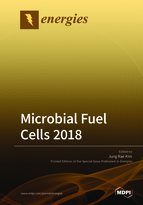Microbial Fuel Cells 2018
A special issue of Energies (ISSN 1996-1073).
Deadline for manuscript submissions: closed (31 October 2018) | Viewed by 25129
Special Issue Editor
Interests: biorefinery for bioenergy and platform chemicals; bioenergy production: biogas and bioelectricity, and synthesis of platform chemicals; metabolic engineering for electrochemically active microorganisms; novel microbially inspired useful resource recovery; environmental biotechnology and biochemical engineering; bioelectrochemical systems: enzyme- and whole-cell-based biosensors; design of environmentally sustainable systems and bioprocesses
Special Issues, Collections and Topics in MDPI journals
Special Issue Information
Dear Colleagues,
The rapid growth of world energy consumption and simultaneous waste discharge need more sustainable energy production and waste disposal/recovery technology. In this respect, microbial fuel cell and bioelectrochemical systems, have been highlighted to provide a platform for waste-to-energy and cost-efficient treatment. Microbial fuel cell technology has also contributed to both academia and industry through the development of breakthrough sustainable technologies, enabling cross- and multi-disciplinary approaches of microbiology, biotechnology, electrochemistry and bioprocess engineering.
Thus, to further spread the technologies and to help the implementation of microbial fuel cells, this Special Issue, entitled “Microbial Fuel Cells 2018”, was proposed for the international journal Energies, which is an SCIE journal (2017 IF = 2.262). This Special Issue mainly covers original research and studies related to the above-mentioned topic, including, but not limited to, bioelectricity generation, microbial electrochemistry, useful resource recovery, system and process design, and implementation of microbial fuel cell. Papers selected for this Special Issue are subject to a rigorous peer review procedure with the aim of rapid and wide dissemination of research results, developments and applications.
I am writing to invite you to submit your original work to this Special Issue. I am looking forward to receiving your outstanding research outcomes.
Assoc. Prof. Dr. Jung Rae Kim
Guest Editor
Manuscript Submission Information
Manuscripts should be submitted online at www.mdpi.com by registering and logging in to this website. Once you are registered, click here to go to the submission form. Manuscripts can be submitted until the deadline. All submissions that pass pre-check are peer-reviewed. Accepted papers will be published continuously in the journal (as soon as accepted) and will be listed together on the special issue website. Research articles, review articles as well as short communications are invited. For planned papers, a title and short abstract (about 100 words) can be sent to the Editorial Office for announcement on this website.
Submitted manuscripts should not have been published previously, nor be under consideration for publication elsewhere (except conference proceedings papers). All manuscripts are thoroughly refereed through a single-blind peer-review process. A guide for authors and other relevant information for submission of manuscripts is available on the Instructions for Authors page. Energies is an international peer-reviewed open access semimonthly journal published by MDPI.
Please visit the Instructions for Authors page before submitting a manuscript. The Article Processing Charge (APC) for publication in this open access journal is 2600 CHF (Swiss Francs). Submitted papers should be well formatted and use good English. Authors may use MDPI's English editing service prior to publication or during author revisions.
Keywords
- Microbial fuel cell and bioelectrochemical system
- Bioprocess using a microbial fuel cell
- Sustainable wastewater treatment
- Bioelectricity generation
- Microbial electrochemistry
- Useful resource recovery by microbial fuel cell
- System and process design of microbial fuel cell
- Implementation of microbial fuel cell






